![]()

Discussion
For all-weather usage versus stability it is hard beat the crystal
oscillator when comparing it to an LC based VFO. During transmit mode, it is
necessary to shift the oscillator frequency during transmit to provide an AF
beat note for the other station to copy. A shift of 600 to 800 hertz is normally
used but can ve varied to suit the builder. For crystal controlled oscillators,
it is convenient to shift the oscillator frequency down the necessary offset
during transmit. Oscillator Experiment
Refer to figure 4B. A 7.5 pF cap was used for C1 and the measured
frequency was 7043288 Hz. Next a 68 pF cap was used for C1 and the frequency
measured was 7039293. The 68 pF cap was removed and replaced with a 220 pF cap
resulting in a frequency measurement of 7038650 Hz. Finally a 0.001 uF ceramic
cap was tried and the measured frequency was 7038432 Hz.
Refer to Figure 4C.
Adding just a 22 microhenry inductor as shown resulted in a frequency of 7033091
Hz.
Refer to figure 4D. The 22 uH choke for L1 was retained and a 68 pF cap
was used for C1. The measured frequency was 7039293 Hz. With a 220 pF cap for C1
the frequency was 7033757 Hz. You can draw your own conclusions from these
tests. Offset Circuits
Please refer to figure 3.
Figure 3 shows another method to
shift oscillator frequency down during transmit. It was developed by Wes
Hayward, W7ZOI and is used by permission. Like the offset circuit shown in
figure 2 , the frequency offset is activated by applying positive voltage at the
point labelled VCC switched. This circuit when activated effectively bypasses
the capacitor C1 and connects the crystal to ground, shifting the frequency down
for transmitting. Using the before-mentioned 7.040 MHz crystal, three tests were
conducted with 3 different values for C1. A 68 pF cap gave 7039202 Hz during RX
and 7038366 Hz during TX. A 100 pF cap gave 7038974 Hz during RX and 7038372 Hz
during TX. Finally, a 168 pF cap gave 7038744 Hz during RX and 7038374 Hz during
TX. The results show a pattern which can be used to obtain the desired offset
that you are looking for. The 100 pF cap gave an offset of 602 Hz, which is
perfect! In my personal transceiver, I used a 100 pF NP0 ceramic cap and the
oscillator has very, very good stability. It is unlikely that the transmit
frequency of such a transceiver will be spot-on a standard frequency such as
7040 MHz, however, this has not stopped the rig from providing many enjoyable
hours of use. Conclusion